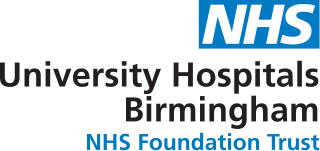
Glenfield Hospital, formally known as Glenfield General Hospital, is situated near Glenfield, on the outskirts of Leicester. It is one of England's main hospitals for coronary care and respiratory diseases. It is a tertiary referral university teaching hospital, with a strong international reputation for medical research in cardiac and respiratory health. It is managed by the University Hospitals of Leicester NHS Trust.
Cambridge University Hospitals NHS Foundation Trust is a British public sector healthcare provider located in Cambridge, England. It was established on 4 November 1992 as Addenbrooke's National Health Service Trust, and authorised as an NHS foundation trust under its current name on 1 July 2004.

The Countess of Chester Hospital is the main NHS hospital for the English city of Chester and the surrounding area. It currently has 625 beds, general medical departments and a 24-hour accident and emergency unit. It is managed by the Countess of Chester Hospital NHS Foundation Trust, one of the first Foundation Trusts in the UK, formed in 2004. Cardiac rehabilitation services at the hospital are provided by Cheshire and Wirral Partnership NHS Foundation Trust.

The Leicester Royal Infirmary (LRI) is a National Health Service hospital in Leicester, England. It is located to the south-west of the city centre. It has an accident and emergency department and is managed by of the University Hospitals of Leicester NHS Trust.

The University Hospitals Birmingham NHS Foundation Trust provides adult district general hospital services for Birmingham as well as specialist treatments for the West Midlands.

Southmead Hospital is a large public National Health Service hospital, situated in the area of Southmead, though in Horfield ward, in the northern suburbs of Bristol, England. It is part of the North Bristol NHS Trust. The 800-bed Brunel Building opened in May 2014, to provide services, which transferred from Frenchay Hospital in advance of its closure. The hospital site covers 60 acres (24 ha).

Weston General Hospital is an NHS district general hospital in the town of Weston-super-Mare, Somerset, England, operated by University Hospitals Bristol and Weston NHS Foundation Trust. As of June 2019, the hospital had 261 beds and around 1,800 clinical and non-clinical staff. It has a part-time Accident & Emergency department, an intensive care unit, an oncology and haematology day unit, and a day case unit. The hospital also has a 12-bed private unit, The Waterside Suite, wholly owned by the hospital trust, with profits being re-invested into the main hospital.

Aberdeen Royal Infirmary is the largest hospital in the Grampian area, located on the Foresterhill site in Aberdeen, Scotland. ARI is a teaching hospital with around 900 inpatient beds, offering tertiary care for a population of over 600,000 across the north of Scotland. It offers all medical specialities with the exception of heart and liver transplants. It is managed by NHS Grampian.

Croydon University Hospital, known from 1923 to 2002 as Mayday Hospital and from 2002 to 2010 as Croydon Hospital, is a large NHS hospital in Thornton Heath in south London, England run by Croydon Health Services NHS Trust. It is a District General Hospital with a 24-hour Accident and Emergency department. The hospital is based on a 19-acre (7.7 ha) site in Thornton Heath to the north of central Croydon.

Leicester General Hospital (LGH) is a National Health Service hospital located in the suburb of Evington, about three miles east of Leicester City Centre, and is a part of University Hospitals of Leicester NHS Trust. It has approximately 430 beds. The hospital is the largest employer in the area.

The University Hospital of South Manchester NHS Foundation Trust is a defunct NHS foundation trust that previously operated Wythenshawe Hospital, a major acute teaching hospital in Wythenshawe, Manchester. Many of the services and facilities previously at Withington Hospital were transferred to Wythenshawe in 2004. It provided services for adults and children at Wythenshawe Hospital and Withington Community Hospital. It runs Buccleuch Lodge Intermediate Care Unit and the Dermot Murphy Centre in Withington, and the Specialised Ability Centre in Sharston.

Bed management is the allocation and provision of beds, especially in a hospital where beds in specialist wards are a scarce resource. The "bed" in this context represents not simply a place for the patient to sleep, but the services that go with being cared for by the medical facility: admission processing, physician time, nursing care, necessary diagnostic work, appropriate treatment, food, cleaning and so forth.
NHS targets are performance measures used by NHS England, NHS Scotland, NHS Wales, and the Health and Social Care service in Northern Ireland. These vary by country but assess the performance of each health service against measures such as 4 hour waiting times in Accident and Emergency departments, weeks to receive an appointment and/or treatment, and performance in specific departments such as oncology.

East Lancashire Hospitals NHS Trust is an NHS hospital trust in Lancashire, England. It was established on 1 September 2002, as the result of a locally controversial, cost saving merger of Blackburn Hyndburn & Ribble Valley NHS Trust and Burnley Health Care NHS Trust, first announced in September 1999.

Central Manchester University Hospital NHS Foundation Trust, was a large NHS foundation trust in Manchester, England, that was founded in 2009 and merged with University Hospital of South Manchester NHS Foundation Trust in 2017 to form the current Manchester University NHS Foundation Trust.
Northumbria Healthcare NHS Foundation Trust is an NHS foundation trust which provides hospital and community health services in North Tyneside and hospital, community health and adult social care services in Northumberland.
The University Hospitals of North Midlands NHS Trust was created on 1 November 2014. It runs Royal Stoke University Hospital, formerly run by the University Hospital of North Staffordshire NHS Trust and the County Hospital. It was formed after the dissolution of Mid Staffordshire NHS Foundation Trust. The trust is currently under the leadership of chair David Wakefield and chief executive Tracy Bullock.
The Five Year Forward View was produced by NHS England in October 2014 under the leadership of Simon Stevens as a planning document.

Private healthcare in the UK, where universal state-funded healthcare is provided by the National Health Service, is a niche market.
Healthcare in Leicestershire was the responsibility of three clinical commissioning groups covering West Leicestershire, Leicester City and East Leicestershire and Rutland until July 2022. As far as the NHS is concerned Rutland is generally treated as part of Leicestershire.















